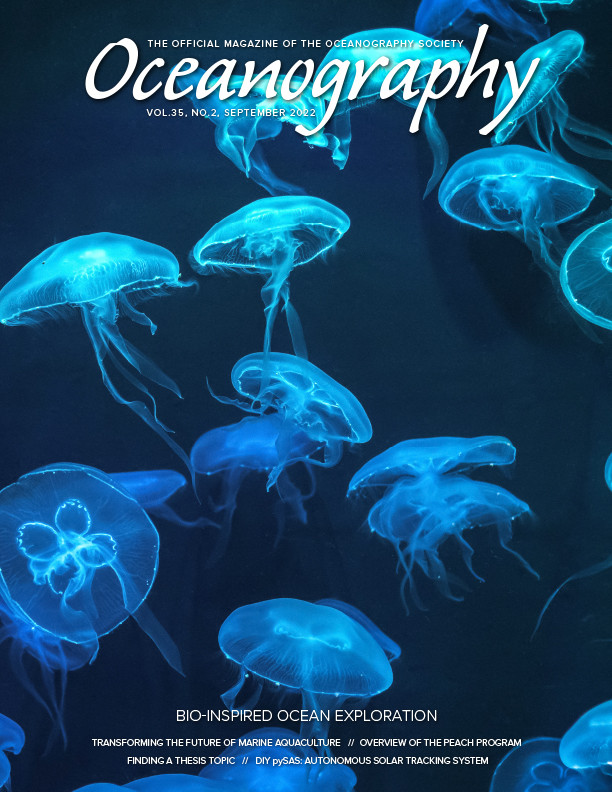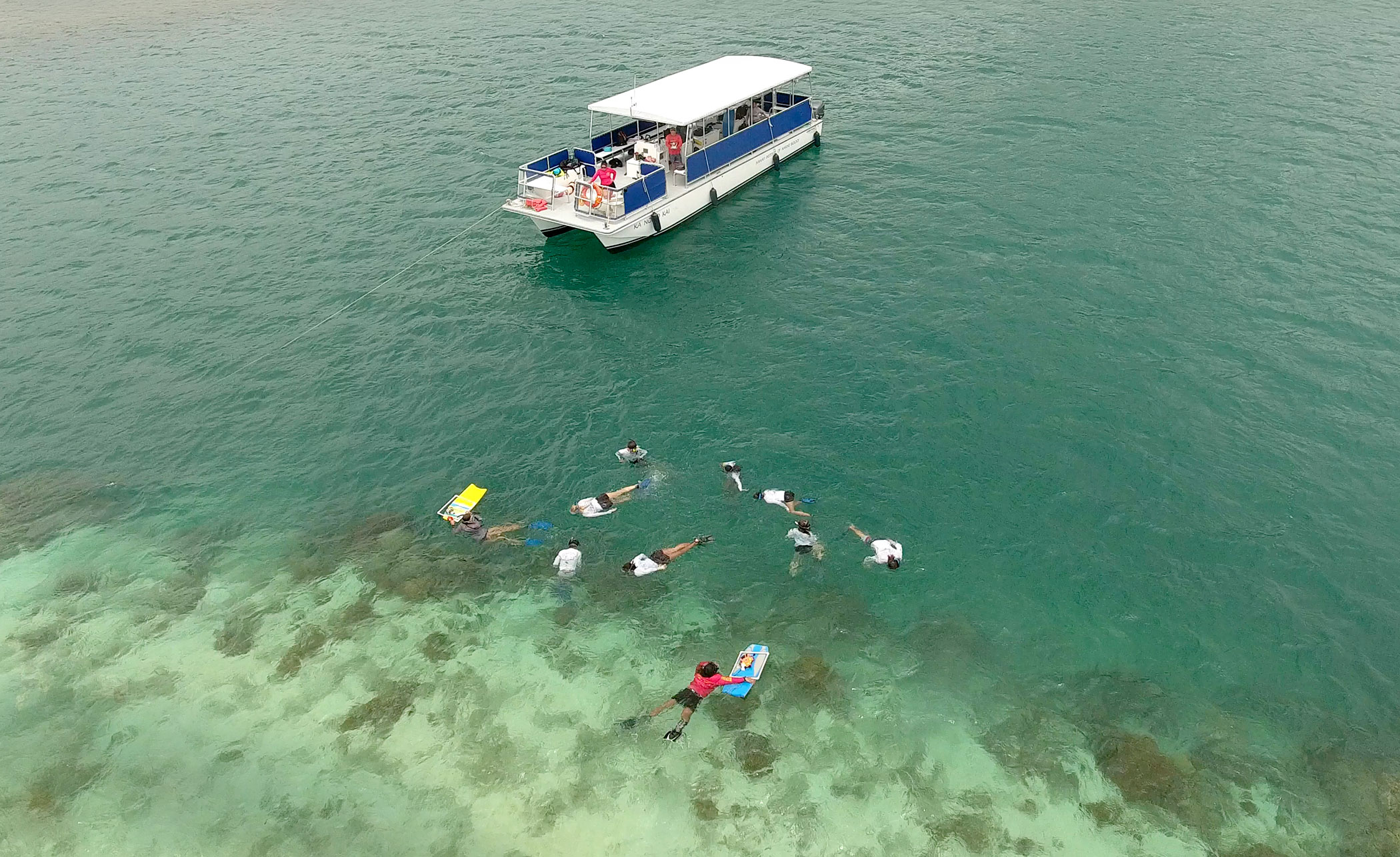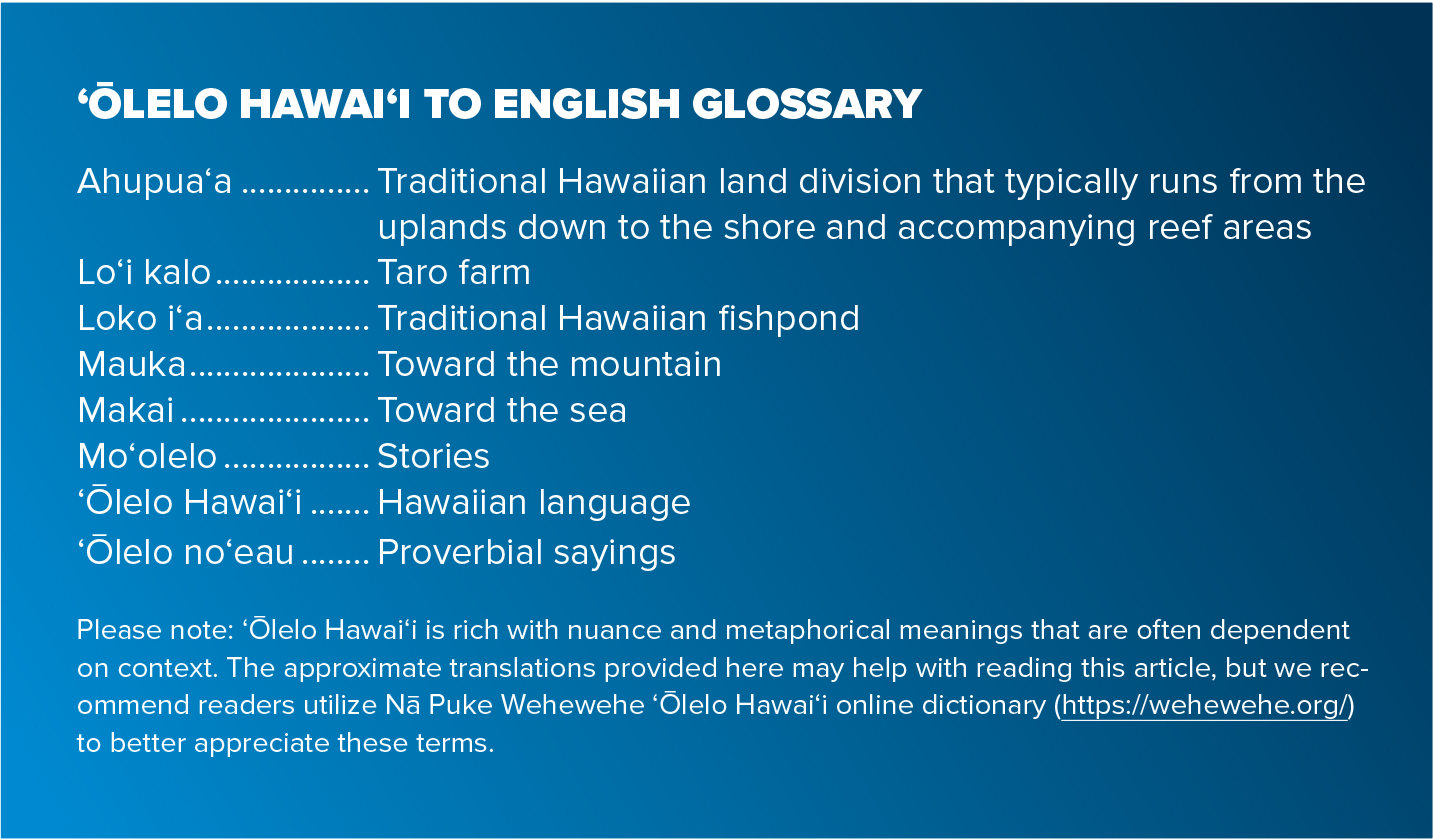INTRODUCTION
As global climate change, resource overuse, and myriad human impacts on the natural environment continue to challenge society, our planet’s sustainability will depend not only on the awareness and stewardship of its citizenry but also on the interest of today’s students in science, technology, engineering, and mathematics (STEM) careers. However, concerns persist that the pool of students proficient and interested in STEM will be insufficient for national workforce demands (Xue and Larson, 2015), a shortfall exacerbated by high attrition among those who enter college as STEM majors (Chen and Soldner, 2013; Kennedy et al., 2021). This challenge is heightened by the fact that students from historically excluded groups face barriers to continuing their education at two- or four-year institutions, let alone in STEM fields, after graduating from high school (NASEM, 2016), thus continuing to hinder diversity in disciplines that lead to sustainability-focused careers. Addressing issues of implicit and explicit biases that pose barriers to pursuing STEM is important in and of itself, but also because diverse research teams have been demonstrated to outperform more homogeneous teams, as members with different backgrounds can bring a variety of valuable experiences and perspectives to problem-solving (Hong and Page, 2004).
Course-Based Undergraduate Research Experiences (CUREs) that involve STEM students in the practice of scientific investigation early in their undergraduate careers have been embraced as one way to better engage students from historically excluded groups in science (Bangera and Brownell, 2014). CUREs are unique in that course delivery mirrors a more authentic scientific research process, requiring problem solving to overcome challenges in research designs and involving collaborations with peers as well as more experienced scientists. Taken together, CUREs have potential to contribute to the larger body of scientific knowledge (Auchincloss et al., 2014; Dolan and Weaver, 2021). CURE pedagogies can be especially effective among students from diverse backgrounds, along with increasing student science identity and self-efficacy in science (Ballen et al., 2017). Additionally, as the nature of CURE experiences allows more space for students to engage in science-related issues that may be relevant beyond the classroom (e.g., to a variety of stakeholders and/or one’s own community), they may better resonate with student groups who tend to be more culturally and community grounded (Malotky et al., 2020).
In this paper we describe our methodology for an innovative CURE model that targets students at or recent graduates from Hawai‘i high schools and present program evaluation results derived from student participant feedback. The context of our CURE focuses on marine science education and research at the University of Hawai‘i at Mānoa (UHM), a Native Hawaiian serving institution and the flagship university campus for the State of Hawai‘i. The primary intent of the program is to help students enter into undergraduate pathways in marine-related natural science majors within the UH system of campuses, which are comprised of seven community colleges and three universities across the state’s main islands, and whose overall enrollment comprises a majority of students who are graduates of Hawai‘i high schools.
Institutional Context
Located in the middle of the Pacific Ocean, the University of Hawai‘i at Mānoa provides educational pathways in STEM especially relevant for our state and for broadening participation in marine science. Hawai‘i’s population is the most diverse in the nation (Morgan, 1996), and Hawai‘i is one of only a handful of states already characterized by a “majority minority” (US Census Bureau, 2021), its populace being largely comprised of mixes of a number of races, including Native Hawaiian, Pacific Islander, Asian, and various other minority immigrant groups. Families with multiracial backgrounds typify populations in the islands, a highly unique demographic make-up that is mirrored by student populations in the Hawai‘i public school system (Office of the Superintendent, 2020). At UHM, however, while nearly 60% of the student body are graduates of Hawai‘i high schools (public and private; Figure 1), relatively few Hawai‘i students pursue STEM degrees in subjects relating to the marine and ocean sciences (see Table 1).

FIGURE 1. Percentages of Hawai‘i high school graduates declaring Marine Biology (total N = 407) and Global Environmental Science (Oceanography, N = 98) undergraduate majors at the University of Hawai‘i at Mānoa relative to total student body (N = 13,203). Mānoa Institutional Research Office, fall 2020 data. > High res figure
|
TABLE 1. Percentages of minority ethnicities in the State of Hawai‘i, at the Hawai‘i Department of Education, at the main university campus (UHM), and in marine and ocean sciences majors at UHM. Sources: aUS Census 2020. bSchool Year 2019–2020 HIDOE Data Book Appendix C. cUniversity of Hawai‘i Institutional Research & Analysis Office, IRO Base Table Spring 2021. dMarine Biology and Global Environmental Science (oceanography) undergraduate majors at the University of Hawai‘i, Spring 2021 Enrollment Report, University of Hawai‘i Institutional Research & Analysis Office. > High res table
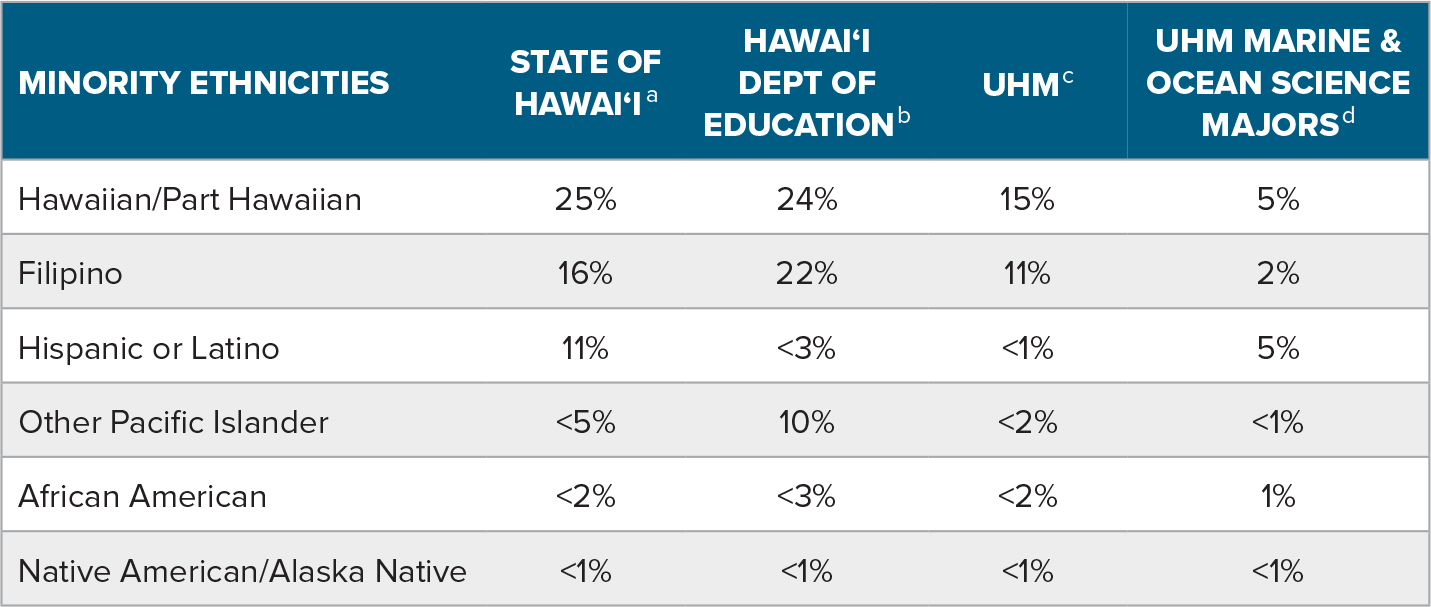
|
A closer examination of enrollment statistics at UHM reveals that despite the majority of the overall student body being comprised of graduates from Hawai‘i high schools, only ~39% of the majors in the oceanography department (a diverse degree called “Global Environmental Science”) and a mere 13% of Marine Biology majors are Hawai‘i high school graduates (Figure 1). The number of students of Native Hawaiian ancestry in these fields is especially low and thus remains so in subsequent local work forces (Kana‘iaupuni et al., 2021).
There is a clear need to develop opportunities to broaden participation in ocean STEM college and professional careers and bolster local workforce development among Hawai‘i’s diverse populations so that local residents actively serve in careers that manage resources and train future stewards in their home state. To do so, students from diverse communities need better access to meaningful and memorable hands-on experiences in investigative science, delivered within a context of environmental familiarity and social relevance. Hawai‘i’s unique multiracial students deserve experiences that balance scientific investigation with an approach that acknowledges, honors, and interweaves ways of knowing that reflect Hawai‘i’s Indigenous host culture and its local communities that have long been marginalized. Indeed, the most recent UHM strategic plan (University of Hawai‘i at Mānoa, 2019) honors the generations of knowledge of our state’s Indigenous culture by prioritizing its efforts as a student-centered, Carnegie Research 1, community-serving university that is grounded as a Native Hawaiian place of learning. Emphasizing tenets of kuleana (responsibilities and purposes) and aloha ‘āina (a recognition, commitment, and practice of sustaining the ea—or life breath—between people and the natural environment), cultivating a Native Hawaiian environment, and promoting Native Hawaiian community engagement embraces all of Hawai‘i’s diversity while honoring the generations of knowledge of Native Hawaiians and our Hawaiian island home.
Intersection of CUREs with Place-Based Education
While descriptions of CURE implementation are prevalent in the literature, few programs have been described as specifically utilizing place-based contexts as the course framework. Place-based education (PBE) is generally defined as the process of using the local community and environment as reference points to teach concepts in various subjects, including STEM topics, across the curriculum. By emphasizing hands-on, real-world learning, PBE is intended to increase academic achievement, help students develop stronger community ties, enhance appreciation for the natural world, and support a strong commitment to active citizenry (Sobel, 2004).
As it integrates a deliberate consciousness of a holistic concept of place in the curriculum (Semken and Brandt, 2010), PBE has been described as an experiential and interdisciplinary way of learning (Semken and Freeman, 2008). The point of this pedagogy is that learning should not be physically confined to the school building alone. As students’ lives continue beyond the classroom, so should their learning environment. Community engagement practices, common in place-based pedagogy, impart a sense of local responsibility and can engage students who might not otherwise see the real-world need for education (Nespor, 2008). The benefit and practicality of utilizing place-based education are that the foundations for learning and communicating are inherent in all participants (i.e., the instructors and the students), due to their intrinsic relationship with a particular place.
Place in the Science Classroom
“Cultural discontinuity” between what the students experience in the science classroom and what they experience in their home communities is a major barrier to persisting in STEM fields, even for students from communities that nurture a culturally strong sense of place (Semken, 2005). However, many concepts of science literacy are applicable to other disciplines or aspects of everyday life (e.g., observation, critical thinking/writing, problem solving), where students are better able to integrate these important skills with a clear connection to their own experiences. Curricula that embrace PBE can give students a better sense of practical applications for their knowledge outside of the physical classroom (van Eijck and Roth, 2009).
Some scientific content areas, such as biology, ecology, or environmental science, present a convenient platform for integrating place-based pedagogy with rigorous scientific methodology, as these content areas highlight the importance of the common themes/concepts of interconnectedness and relationships that are woven throughout diverse knowledge systems. For example, Hawaiian concepts of natural resource stewardship emphasizing mauka to makai, or land-sea connections, closely mirror contemporary watershed resource management practices. Other concepts of food web dynamics, the effects of pollution on ecosystems, and the adaptations of unique, endemic species are all examples of biological concepts that reflect the importance of relationships in PBE.
Hawai‘i offers a unique environment, both biologically and socially, to utilize PBE for science teaching and learning because cultural and environmental integration are vital to the Hawaiian sense of place (Kana‘iaupuni and Malone, 2010). Hawai‘i students, and in particular Native Hawaiian students, face high rates of attrition and low representation in STEM academic and career pathways, but place-based education that is culturally grounded, relevant, responsible, and sustainable can help to empower their voices (Kana‘iaupuni and Kawai‘ae‘a, 2008; Thomas et al., 2014; Hadfield et al., 2016). Place-based science classes in Hawai‘i can include use of Hawaiian animal names or field trips to a local watershed (Kuwahara, 2013), incorporate the use of indigenous or endemic Hawaiian species and mo‘olelo (stories and legends) or ‘ōlelo no‘eau (proverbs and sayings), access cultural practitioners and resource managers, or conduct experiential fieldwork in tropical coral reef ecosystems. These pedagogical elements help to connect students with their local environment and can engage students who might not otherwise be interested in scientific fields.
A Unique Ecological and Cultural Setting for Marine Education
Located on an islet called Moku o Lo‘e in Kāne‘ohe Bay off the island of O‘ahu, the Hawai‘i Institute of Marine Biology (HIMB) is an ideal setting for place-based experiential education and engaged student learning. Moku o Lo‘e is surrounded by 64 acres of fringing coral reef designated as the Hawai‘i Marine Laboratory Refuge (Figure 2). HIMB’s state-of-the-art facilities, combined with its unique location and proximity to estuarine, coastal, and offshore environments, promote the integration of cutting-edge laboratory experimentation, rigorous fieldwork, and science education.
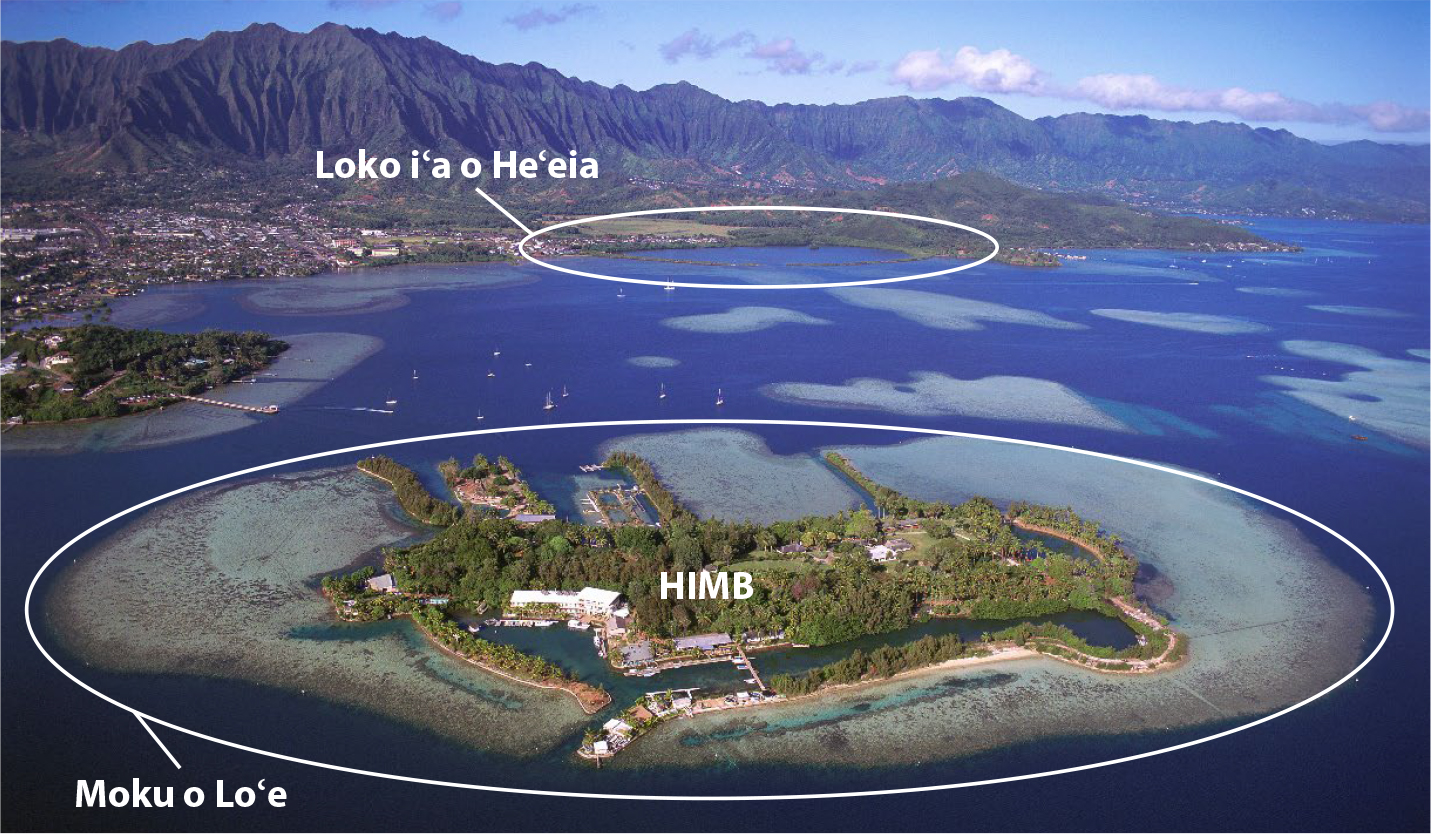
FIGURE 2. The Hawai‘i Institute of Marine Biology (HIMB) sits on an islet, Moku o Lo‘e, adjacent to a loko i‘a (Hawaiian fish pond, center right background) in Kāne‘ohe Bay, O‘ahu. Surrounded by a living coral reef, Moku o Lo‘e provides an ideal place-based learning setting for the Research Experiences in Marine Science (REMS) Summer Program. Photo credit Douglas Peebles. > High res figure
|
The institute’s unique location on Moku o Lo‘e gives it the distinction of being a world-class research institute that is situated on a protected living coral reef. This special environment provides ample opportunities for utilizing PBE at HIMB’s Marine Science Research Learning Center (MSRLC), which is designed as an indoor-outdoor laboratory-classroom. In addition to its research infrastructure, the rich cultural history of Moku o Lo‘e and its ahupua‘a1 includes Hawaiian legends and their descriptions of a vibrant and meaningful spiritual and physical world. He‘eia, the name for Moku o Lo‘e’s ahupua‘a, is associated with numerous Hawaiian mo‘olelo, and the flora and fauna within this area are subjects of many Hawaiian ‘ōlelo no‘eau that represent deep ancestral understanding of the habitat, organisms, and their seasonality and trends. In traditional times, this area was home to a thriving agricultural and aquacultural network of lo‘i kalo (taro wetlands) and loko i‘a (Hawaiian fishponds) that sustained a large resident population. In 2017, the He‘eia National Estuarine Research Reserve (NERR) was designated as part of an effort to sustainably manage resources within Kāne‘ohe Bay through culturally grounded stewardship; it is consistent with the principles and values of Native Hawaiian ahupua‘a land and resource management. Restoration of lo‘i kalo and loko i‘a are now underway through the extensive removal of mangroves and other invasive species and rebuilding of the kuapā (fishpond rock walls) to once again support food production and related agricultural services. With its administrative home at HIMB, the He‘eia NERR is managed in partnership with several Native Hawaiian community organizations as well as federal and state agencies. The aim of this collaboration is to encourage and facilitate research, education, stewardship, and cultural practices unique to the He‘eia watershed through biocultural restoration of the ahupua‘a (Winter et al., 2020a,b).
Taken together, Moku o Lo‘e’s cultural backdrop, rich history, and location provide a distinctive environment for integrating scientific research and place-based educational practices. Within this setting, we created a place-based marine science CURE that integrates aspects of the historical, cultural, and socioecological dimensions of Moku o Lo‘e.
1 The traditional Native Hawaiian land division system is based on political and ecological features of the islands. The ahupua‘a typically runs from the uplands down to the shore and extends to accompanying reef areas.
METHODS
Research Experiences in Marine Science at HIMB
To provide access to a meaningful and rigorous marine science experience for Hawai‘i students, we developed a unique, place-based CURE for high school students or recent high school graduates nearing transitions to early college careers. The Research Experiences in Marine Science (REMS) program centers its recruitment efforts in Hawai‘i public high schools, particularly on campuses designated as Title I.2 Students typically are recruited while they are in grades 10 through 12, but occasionally highly motivated ninth graders are invited to apply. Recruitment is primarily facilitated by partners at the high schools (e.g., high school science faculty, and community or university-based programs embedded in the schools such as those funded by US Department of Education TRIO grants3), where colleagues with more intimate working knowledge of potential applicants pre-identify students they feel will most benefit from the program. However, some students do contact HIMB directly and can apply via that route, most often because they previously visited HIMB through one of our other K–12 informal science education field trip programs. Our primary criterion is a demonstrated interest in marine science, environmental science, or conservation and stewardship, with far less emphasis on traditional academic indicators like GPA or standardized test scores. As Hawai‘i is surrounded by ocean, with countless direct connections to the places and cultural contexts in which our island communities live, work and play, generally, local students report a high level of interest in anything to do with the ocean before even coming into the program; however, most have not yet decided on a college major. We simplify the initial application process to just basic contact information, parent/guardian approvals, academic transcripts, short essays describing their motivation for applying, and a letter of recommendation from a STEM teacher to mitigate the possibility of excessive forms themselves posing a barrier to access. As REMS does not require “open-call” recruitment and the majority of applicants are pre-identified by school partners, we tend to receive only as many applications as we have spaces for.
Because of this recruitment approach, our cohorts represent a wide cross section of socioeconomic status, learning styles, and academic achievement, with GPAs ranging from less than 2.0 up to 4.0+ on a four-point scale. Many are potential first-generation college students, and the majority are of the characteristic mixed ancestry of the state, with 75% self-reporting to be part Native Hawaiian. To support student participation and encourage commitment for the duration of the course, the program covers all costs of tuition and research expenses. In addition, the program provides a modest stipend to offset any potential income loss should students otherwise intend to seek summer employment. The program also supplies healthy snacks throughout the day to support their learning. To facilitate access to HIMB, transportation to and from Moku o Lo‘e from their school or a nearby community site is also provided.
The REMS course itself is a four-credit, “early-admit” entry-level college course that utilizes the expertise of HIMB researchers whose specialties demonstrate how human impacts and global change affect coral reef ecosystems. It incorporates important tenets of Hawaiian sense of place, including various cultural, historical, and ecological resources available via surrounding community partnerships and within the larger university system. We start the course with establishing a sense a place through introducing the Native Hawaiian system of land division and management using He‘eia as an example, and share mo‘olelo of He‘eia and Moku o Lo‘e. During the program, students participate in field- and laboratory-based marine science modules and conduct independent research projects in small groups under the guidance of a team of diverse faculty who represent various disciplines (biology, ecology, neuroethology, oceanography, Hawaiian language, evolution, science education, education research), positions (teachers, scientists, postdocs, graduate students, undergraduate interns), institutions (community college, research facility, Native Hawaiian resource management, federal research reserve), and career levels (undergraduate interns through tenured professors). Course modules broadly encompass topics in coral biology, ecology and resilience, coral reef biodiversity, marine chemistry with emphasis on ocean acidification (Gorospe et al., 2013), water quality and invertebrate fertilization, (Haverkort-Yeh et al., 2013), animal behavior (Ambrosino and Rivera, 2020), bioacoustics (Fox et al., 2013), and fisheries and aquaculture (Tamaru et al., 2014). The practice of the scientific method is woven throughout all topics, while very deliberately utilizing Hawaiian names of organisms, Hawaiian place names, relevant ‘ōlelo no‘eau (which often have ecological and biological inferences), and connections to Hawaiian spirituality (i.e., through the Kumulipo, the Hawaiian creation chant, in which all life began with a coral polyp). We encourage students to begin their projects using the Hawaiian practice of kilo, a form of observation that incorporates all five senses and is the foundation of understanding and connecting to the natural world. Topical content is taught over a two-week period using active learning and student-centered pedagogies, which have been shown to increase student performance in STEM (Freeman et al., 2014), particularly for students from historically marginalized groups (Theobald et al., 2020).
Students are grouped into rotating teams of four that generally consist of three new students, one near-peer mentor (a student who is an alumnus of the program), and one practicing scientist (Figure 3). At the completion of the first two weeks of instruction, final four-person student research teams, under the guidance of a practicing scientific mentor and often in consultation with a Hawaiian scholar or community partner, conceptualize and execute a “mini” novel research plan, analyze their data, and prepare a formal written report on their project over the following three weeks. The course culminates in a final oral presentation at a symposium where students present their results to a large audience of faculty, university leadership, elected government representatives, program funders, community partners, and family members and friends of the students.
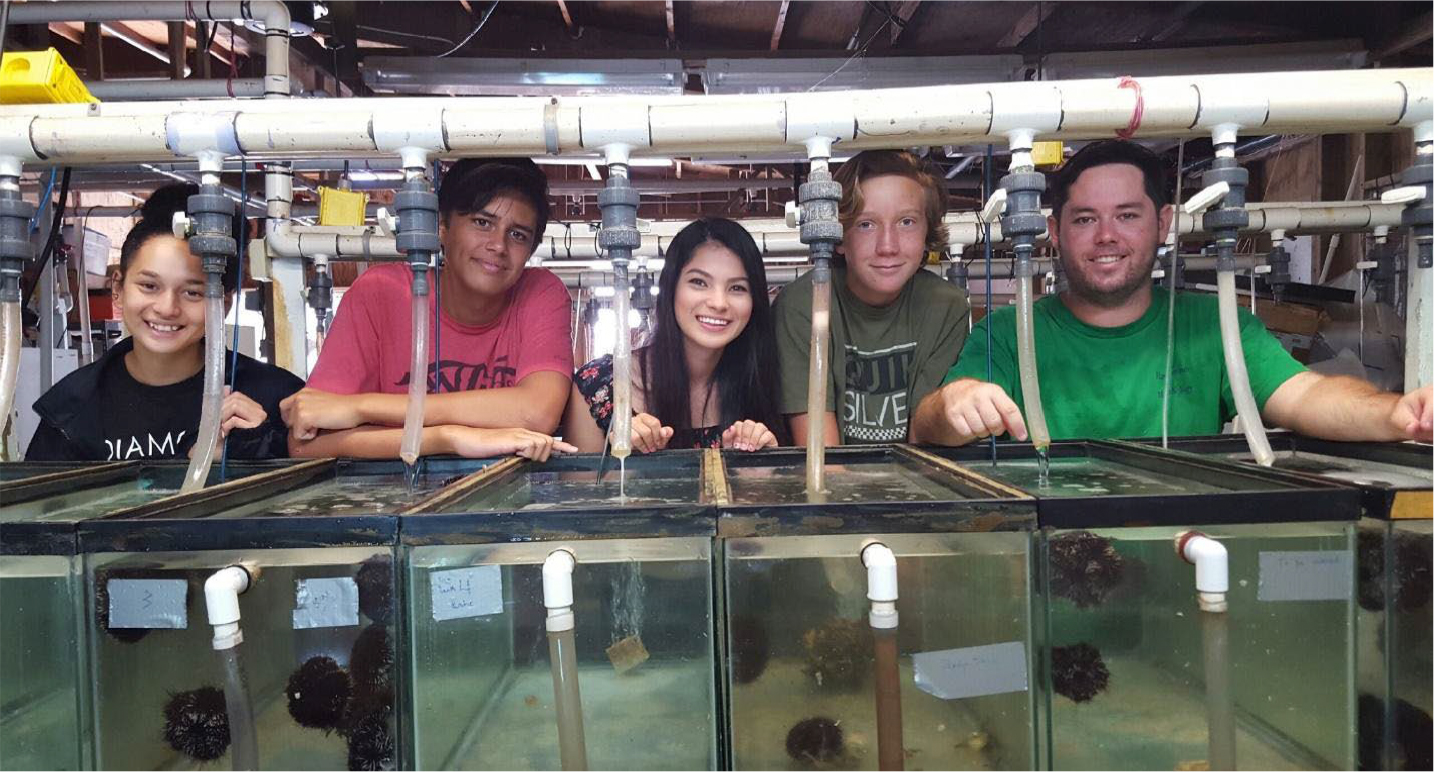
FIGURE 3. Shown in a Hawai‘i Institute of Marine Biology laboratory, this group represents Research Experiences in Marine Science (REMS) teams that are made up of three high school students, one near-peer mentor, and one practicing scientist (i.e., graduate student, postdoc, or faculty member). Photo credit Maile Goo. > High res figure
|
The REMS pedagogical approach centers largely on mentored experiential learning, with students engaged primarily in the field and in the lab, and relatively less emphasis on traditional classroom lectures. Strong emphasis is placed throughout the course on relevance of scientific research to marine conservation, stewardship, and sustainability. We guide and facilitate student formation of connections between scientific content and Hawaiian cultural and societal significance of Kāne‘ohe Bay’s ecosystems, and students are encouraged to explore biological and ecological systems from both Western scientific and Native Hawaiian worldviews during their team research projects. Also embedded within the course is an exploration of educational and professional careers in the natural resources, conservation, and STEM disciplines. Instructional teams are largely composed of graduates of Hawai‘i high schools and/or represent minority ethnicities. They include practicing scientists ranging from tenured faculty to senior graduate students of HIMB or other UHM STEM programs, community partners from the He‘eia NERR and other Hawaiian culture-centered community stewardship programs, seasoned science teachers from local high schools training in our program, and faculty or graduate students from the Kawaihuelani Center for Hawaiian Language at UHM, as well as Indigenous education scholars from within the university’s College of Education Department of Curriculum Studies.
In addition, undergraduate mentors who are alumni of the program serve as near-peer mentors to incoming cohorts of students, an approach shown to facilitate development of science identity among both mentee and mentor students (Trujillo et al., 2015; Atkins et al., 2020), and to help create a learning community that retains students in STEM through a “persistence framework” (Graham et al., 2013). Our unique approach to teaching not only provides students with a meaningful and robust introduction to marine biology and scientific research but also promotes improved understanding of the connection between coastal resources and the effects of human impacts and climate change on coral reef ecosystems within social, cultural, and environmental contexts. Equally important, it provides students with valuable skills in science literacy and communication, teamwork, leadership, and mentoring, and creates meaningful memories that may inspire students to consider related STEM careers.
2 Title I, Part A (Title I) of the Elementary and Secondary Education Act (ESEA), as amended by the Every Student Succeeds Act, provides financial assistance to local educational agencies and schools with high percentages of children from low-income families to help ensure that all children meet challenging state academic standards.
3 Not an acronym, TRIO refers to a number (originally three, now more) of US federal programs designed to increase access to higher education for economically disadvantaged students.
Evaluation
To evaluate the efficacy of the REMS program for student participants, we developed a series of evaluation questions to measure student interest, appreciation of the relevance of marine science to students’ everyday lives, and self-perceived confidence in marine science and the scientific process (Table 2) delivered through the personal response system iClicker (i>clickers) or an online survey platform. Quantitative iClicker survey questions were based on Likert scale responses (1 – poor/strongly disagree to 5 – strongly agree/excellent), administered in a pre-/post-intervention study design. In addition, using the same Likert scale, we administered a survey at the conclusion of the course (post-only) that focused on questions about students’ overall experience in the program. A second post-only, online-platform survey was administered seeking responses regarding students’ feelings about the research experience, specifically whether they enjoyed the experience and whether participation in group research gave them confidence to do future investigations themselves. Finally, we allowed students to provide open-ended comments in both a pre- and post-manner in response to a prompt asking if they had any comments on the course experience, again using an online survey platform. As this was a college credit generating course, students were also assessed by the instructor team using letter grades (A–F). These grades were based on quiz scores, participation in lab and field exercises and final research projects, and evaluation of final papers and presentations.
TABLE 2. Research Experiences in Marine Science (REMS) program timeline, mentoring structure, and survey instrument administration schedule. > High res table
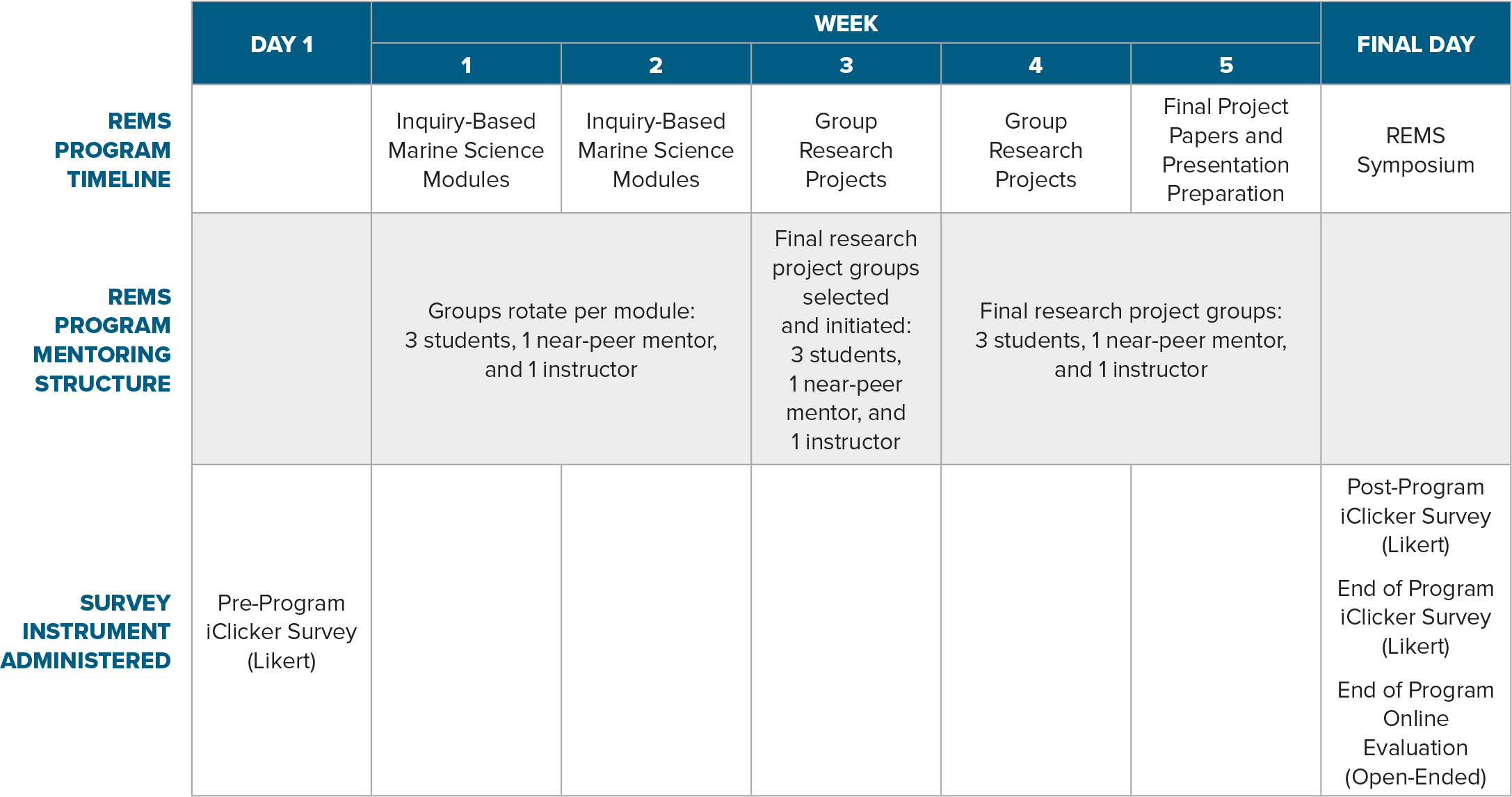
|
PROGRAM OUTCOMES AND EVALUATION DATA RESULTS
A total of 110 new students, all from Hawai‘i high schools, participated in the REMS program described here during summers between the years 2013 and 2018, with each cohort generally comprised of ~18 new students and ~six near-peer (REMS alumni) mentors. Retention and completion during each execution of the course was extremely high, with only two enrolled students withdrawing from the course out of the 110 (both having had personal or family emergencies) and passing grades (averaging “B”) among the remaining participants. Final student projects spanned a wide array of topics and research areas, including those that interwove community connections and Hawaiian culture and knowledge. Table 3 shows some examples of these student projects. Following a hiatus partially resulting from the COVID-19 pandemic, a spring semester program was organized for early 2022 as a pilot for the future.
TABLE 3. Examples of novel student research projects conducted during the last three weeks of the REMS program experience. > High res table
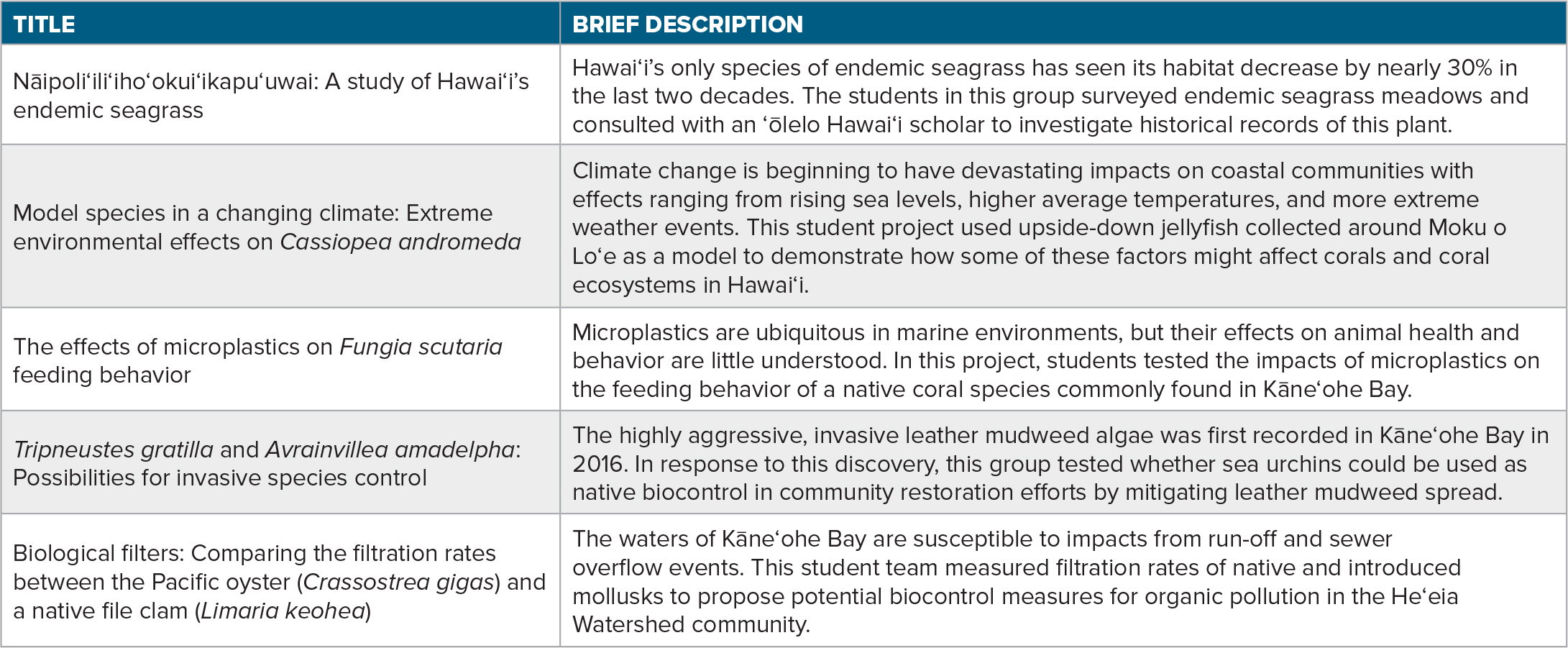
|
Response rates were high for all evaluation questions, resulting in negligible missing data. For iClicker administered questions, we were able to collect data only from the 2014–2018 cohorts (N = 84 students). For Likert questions asked via online surveys, we collected data from all cohorts between 2013 and 2018 (N = 105). Missing data within these collections ranged between 1% and 5%. Students from the 2017–2018 cohorts provided pre- and post-program open-ended responses to a general prompt (N = 34). We chose to analyze the Likert data by comparing pre- vs. post-program iClicker and online survey responses with paired Student’s t-tests. As we assumed no directionality, we applied a two-tailed test with significance denoted at an alpha of 0.05.
The response means and standard deviations calculated for each of the five pre- and post-program Likert questions (Figure 4a, N = 84), focusing on student self-reported awareness, understanding, interest, and personal relevance, ranged from 3.76 to 4.94 (pre-scores) to 4.55–4.97 (post-scores). Four of the five questions posed showed significant increases after program participation, indicating students perceived gains in relation to (1) understanding how to make and test a hypothesis (p <0.00001), (2) awareness of relevance of marine science to their lives (p <0.001), (3) interest in the subject of marine science (p <0.00001), and (4) interest in careers in marine science (p <0.00001). The only item that did not show a significant increase was the question on caring about protecting Hawai‘i’s marine environment (p = 0.431). However, the average pre-score for this item was relatively high (4.94 of 5) compared to the post-score (4.97), indicating student participants already placed high value on protecting the marine environment coming into the program. Conversely, the lowest pre-score mean was associated with the item asking about interest in marine science careers (3.76). This item also showed the largest mean gain in the post-score (4.55), a difference of 0.79 points. This was closely followed by the question about relevance of marine science to students’ lives, with an increase of 0.73 in the average post-score. Like the other two items, these changes indicated strongly significant shifts in student agreement.
Two post-program questions focused on students’ feelings about the research experience and their confidence in doing research as a result of the final group project. For this response, 88.6% of students strongly agreed and 8.6% agreed the research experience was enjoyable (mean score = 4.84), while 68.6% strongly agreed and 22.9% agreed that they felt the group research gave them confidence to execute a research project on their own (mean score = 4.84; Figure 4b, N = 105).
For the post-only iClicker questions regarding student feelings about the course, 96.5% of students rated their overall time at HIMB “excellent” (mean score = 4.97) and 93.9% indicated they “strongly agreed” they learned something new and important (mean score = 4.94). Slightly fewer respondents (85.1%) “strongly agreed” the science activities were fun and interesting and 14.0% “agreed” with this statement, for an overall total of 99.1% of participants responding positively (mean score = 4.83; Figure 4b, N = 84).
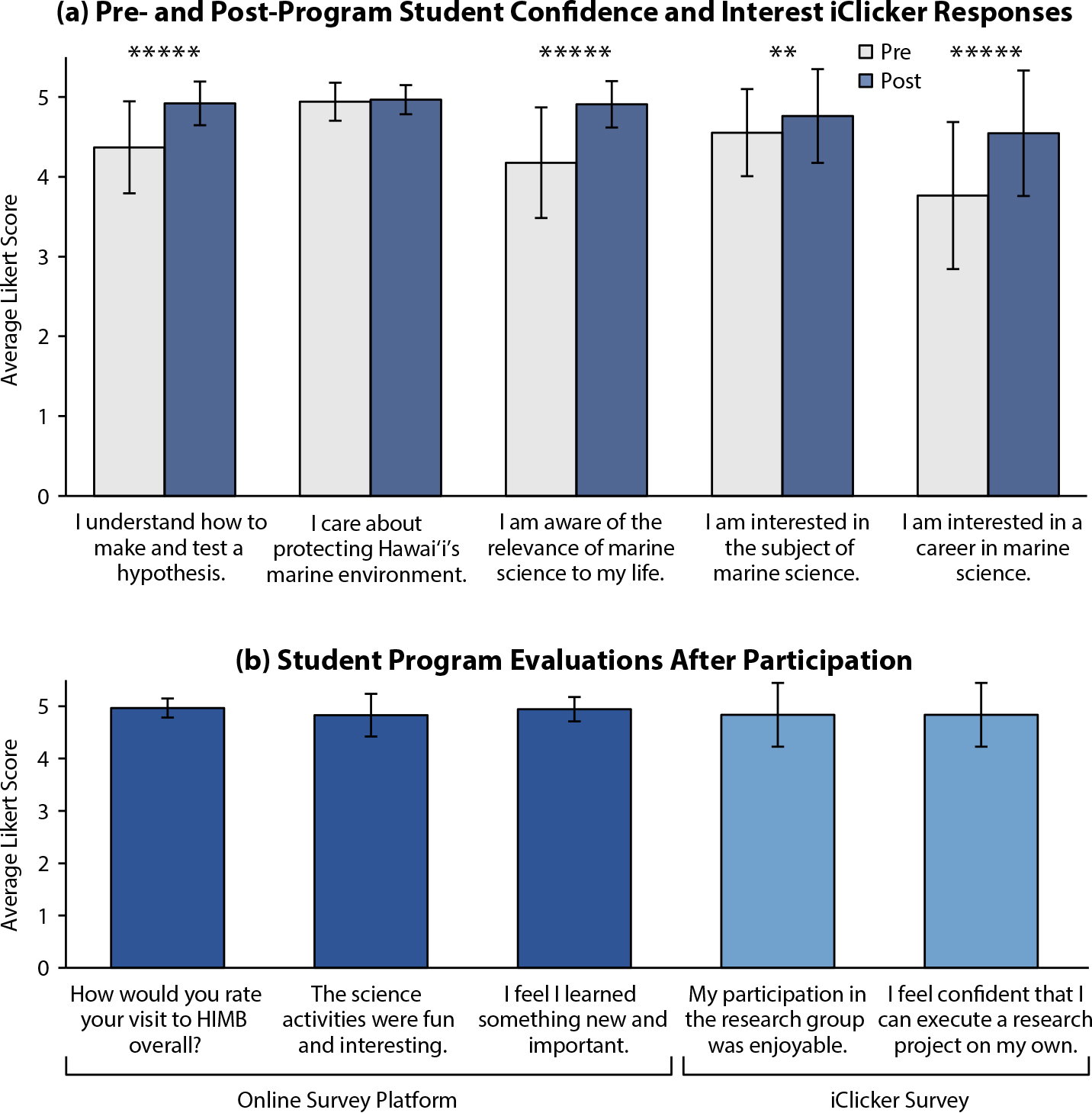
FIGURE 4. (a) Mean Likert responses with standard deviations in pre- and post-program iClicker surveys showing student self-reported gains in understanding of hypothesis testing, environmental stewardship, and marine science relevance, and in interest in marine science subjects and careers (N = 84; **p <0.001, *****p <0.000001). Highest gains after the program were observed in relevance of marine science and interest in marine science careers. (b) Post-only mean responses with standard deviations solicited from an online survey platform (dark blue; N = 84) that focused on students’ feelings about the research experience and confidence in doing research, and an iClicker Likert survey (light blue; N = 105) that focused on student feelings about the course. > High res figure
|
Open-ended responses to the general prompt asking students to provide any comments regarding their participation in the program (cohorts 2017–2018), administered both before and after the course, also yielded interesting results. Of the 34 participants surveyed, only five (14.7%) responded to the pre-program survey prompt, all with comments about being excited and looking forward to being part of the program. However, in response to the post-program survey prompt, 21 of 34 (61.8%) students provided narrative comments, 100% of which were extremely positive in nature; they included comments on how the experience helped discover their love of marine science and how fun and memorable the program was for them. Verbatim responses are shown in Table 4.
TABLE 4. Unedited student responses to pre- and post-program open-ended survey items regarding general program comments. > High res table
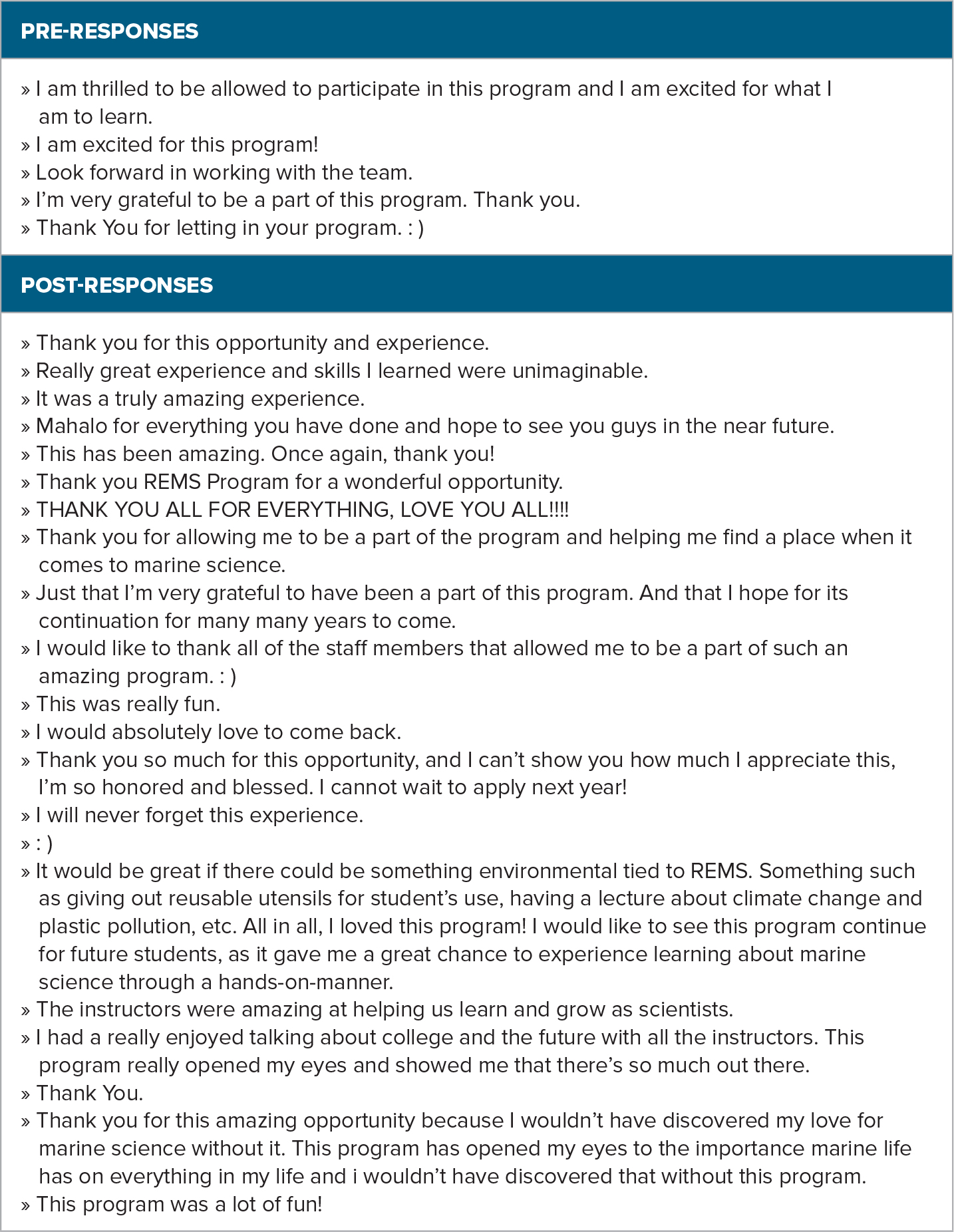
|
DISCUSSION
Given Hawai‘i’s strong cultural and societal connections to the ocean, the state’s economic reliance on marine resources, and the islands’ geographic location surrounded by the Pacific, people who grow up in Hawai‘i typically have a high interest in anything associated with the marine environment. Historically however, this high interest has not proportionately translated to enrollment in marine related majors at UHM, an issue that drove the creation of REMS. Thus, while the high pre-program Likert response means we observed were not surprising, the results still suggest that students are making significant gains in interest, awareness, and confidence in marine science and scientific investigation skills as a result of participating in the HIMB REMS program. Evaluative indices show students strongly felt the program was enjoyable, interesting, and valuable in terms of learning new things, and overall they rated their experiences at HIMB extremely high. They also strongly indicated that the research experience was highly enjoyable, and that they now feel more able to execute scientific projects independently, having had training through the REMS program. The open-ended comments revealed a very high level of enthusiasm, with the majority of students expressing strong sentiments in describing the program with words such as “amazing,” “unimaginable,” and “fun.” Comments such as these show students were inspired by the experience and perhaps motivated to pursue transitions to college careers in marine related STEM.
Many student alumni of REMS report having developed a strong interest in science as evidenced by continued participation in either REMS or other STEM programs. In fact, many of them have come back to participate in subsequent iterations of REMS; thus far, a total of 22 alumni have returned to serve as near-peer mentors for incoming students, and three have done so more than once. Further, 12 REMS alumni returned to participate in an immersive six-week summer research intensive and year-long professional development workshop series called REMS Excel, nine have participated as undergraduate research interns in various HIMB or other UH campus research labs, and two have returned to HIMB as post-baccalaureate research interns as they prepare to apply for graduate school. In addition to program staff facilitating and supporting REMS alumni transitions to other formal research and professional development opportunities at HIMB, UH, or beyond, REMS instructors also continue to serve as mentors for alumni long after participation in REMS ends, providing ongoing advice on courses, internships and academic pathways, and equally important, in navigating life as a high school graduate or college student from Hawai‘i, whether in STEM, other fields, or not in college at all. While longitudinal tracking is challenging and labor intensive (and often unfunded), we strive to collect information on actual student enrollment numbers in college after participation in REMS through interactions via social media, individual emails, personal conversations, and informal post-program surveys. Many students continue to communicate with program staff, seeking college courses and/or college major advice, requesting letters of recommendation, and facilitating linkages to relevant community based or research internships. We have even held fun, social “reunion” events to help us maintain relationships to students and students’ relationships to one another. Through these ongoing mentoring efforts, we know a majority of REMS alumni did transition to undergraduate programs, with approximately 20–25 going on to college careers specifically in marine science related degree programs and at least two entering graduate degree programs.
Despite the success of the REMS program in providing access to meaningful and authentic marine science research experiences for Hawai‘i students, overall it is a relatively small program, and there is much room for improving recruitment at the undergraduate level. Interdisciplinary interactions between STEM scientists and K–12 educators engaged in transforming STEM education are relatively scarce but are increasingly necessary to address these issues at the secondary to tertiary interface. Hawai‘i’s scientists and educators have an influential role to play to help increase interest in science and potential career pathways from local high schools by enhancing science literacy, ocean and climate literacy, and building understanding of the inherent connectedness of land and sea ecosystems to the sustainability of our islands.
This is particularly important in Hawai‘i, as secondary and post-secondary education systems are critical in supplying the state’s STEM marine science and conservation occupations with trained professionals who are more likely to remain in the state because of strong social, cultural, and familial ties to the islands. A report by the Hawai‘i Science and Technology Institute (2008) revealed the ocean science and technology sector to have one of the fastest annual growth rates (5.2% compared to 2.9% for all Hawai‘i science and technology sectors, and 2.5% for the overall economy), and estimated a requirement for 16,500 new workers with knowledge, skills, and abilities in STEM technology fields for the next decade. One of the key recommendations in this report was that Hawai‘i develop a comprehensive workforce retention strategy to keep and train local talent in the islands to fulfill projected needs and maximize potential for growth in STEM. UHM recruitment into these disciplines may be hindered by a paucity of opportunities for Hawai‘i’s students to engage in authentic STEM research activities that allow them to explore potential interest in these fields early in their educational experiences (e.g., high school level or younger). It may be further hampered by classroom science education that does not provide any real or direct connections to the places and cultural contexts in which our communities live, work, and play, exacerbated by introductory STEM courses at the college level that are perceived as “uninspiring” or “unengaging” (President’s Council of Advisors on Science and Technology, 2012). Institutional funding is another key hurdle; aside from the program director’s salary, the REMS program is entirely extramurally funded on an annual basis, primarily by private foundations. More predictable funding would help address and mitigate some of our ongoing challenges.
Lessons Learned
REMS provides a unique, place-based CURE model for creating science experiences that better resonate with Hawai‘i’s students. We believe the overwhelmingly positive responses to the REMS program are a result of several distinctive elements that we consider essential to the success of the program and that lay foundations for fostering student persistence in STEM pathways. With each iteration of the program over the six summers REMS was offered, improvements based on lessons learned were incorporated in subsequent years, while others remain a challenge. Some of these include:
- Build a network of partners within local high schools that can better identify potential students who would most benefit from participating in a program like REMS.
- Simplify the application process so the application itself is not a difficult barrier to access for students to overcome.
- Allocate resources to support on-the-ground recruitment and facilitate participant application processes, as students from historically excluded groups are often more reticent to apply for programs like REMS without this support.
- Place a strong emphasis on sense of place, cultural relevance, and Indigenous knowledge and ways of knowing, along with community connections, to make science personally relevant to students and their everyday lives.
- Collaborate across disciplines, including with experts in language, culture, and Indigenous and place-based education.
- Support a strong, tiered mentoring structure that includes near-peer mentors, undergraduate interns, graduate students, postdoctoral scholars, and interdisciplinary faculty whose life experiences closely resemble those of the students they are mentoring.
- Allocate more resources for longitudinal tracking, ongoing advising and mentoring, and formal education evaluation and research expertise.
- Establish communication with university administration to support frameworks for early college efforts with appropriate funding.
We believe students highly value these strategies, that is, knowing that instructors, staff, mentors, and administrators acknowledge, honor, and encourage cultural and community connections, transdisciplinary approaches, and diverse ways of knowing. We believe diverse student participation in STEM can be facilitated using a framework that provides continued support and individualized mentoring along the long pathway to college and professional careers through advising, counseling, and bridging to further learning and internship opportunities.
ACKNOWLEDGMENTS
We are grateful for the many significant contributions of people and programs throughout the years that have made REMS a success. Funders have included the Hau‘oli Mau Loa Foundation, Harold K.L. Castle Foundation, Pacific American Foundation, Carol Ann and Myron Hayashida, Omidyar ‘Ohana Fund, Tanaka Memorial Foundation, National Science Foundation via PREL, Smithsonian Institution Youth Access Grant, SEED, METS, GPA and PLACES Programs at UHM, NOAA BWET, He‘eia NERR, and other private donations. The invaluable instructors, collaborators, staff and other supporters of REMS include Jeremy Soriano, Alexi Meltel, Hoaka Thomas, Ka‘ilikea Shayler, Maile Goo, Cindy Sunada, Roxanne Haverkort-Yeh, Bethany Kimokeo, Laiana Wong, Margie Maaka, Mary Hagedorn, Nakoa Goo, Jan Vicente, Fred Reppun, ‘Ale‘a Dudoit, Ariana Huffmeyer, Gerry Clarin, Kaleonani Hurley, Kelly Williams, Kyle Landers, Mareike Sudek, Rene Francolini, Robinson Bucaneg, Sarah Tucker, Kai Fox, Zack Oyafuso, Amber Caracol, Janis Dela Cruz, Kelsey Maloney, Akamu Jaber, Seaenna Correa-Garcia, Sarai Del Rosario, Jovit Marks, Kahiau Miranda, Fritz King, Dan Brinkman, and Mindy Mizobe, as well as all the near-peer student mentors. We are also humbled by the support of UHM leadership in Office of the Provost, SOEST, and Outreach College, especially Michael Bruno, Chip Fletcher, and Bill Chismar, at Windward Community College, especially Dave Krupp and Ardis Eschenberg, past HIMB Directors Jo-Ann Leong and the late Ruth Gates, and former State Senator Clayton Hee. Collection, analysis, and management of student data used for evaluation was conducted in accordance with approved UHM Institutional Review Board Protocol #2019-0065.

